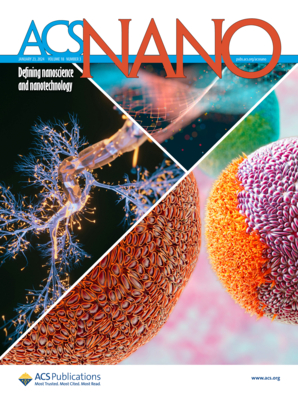Acoustofluidic Fabrication of Calcium Pyrophosphate-Enzyme Nanocatalysts for Oral Treatment of Metabolic Disorders.
IF 15.8
1区 材料科学
Q1 CHEMISTRY, MULTIDISCIPLINARY
引用次数: 0
Abstract
Catalytic medicine, particularly enzyme-based therapies, has emerged as a promising approach for disease treatment. However, the development of enzyme-based catalytic medicines faces significant challenges, including a complex fabrication processes, poor stability, and limited efficacy in oral administration. Herein, we present an approach to fabricate calcium pyrophosphate (CaP)-enzyme nanocatalysts via acoustofluidic synthesis, enabling rapid and scalable encapsulation of natural enzymes (e.g., uricase, alcohol oxidase, and glucose oxidase). This technique achieves an enzyme loading capacity of ∼45%, significantly surpassing traditional methods. The porous architecture of CaP nanoparticles provides extensive reaction channels, preserving the enzymatic kinetics comparable to free enzymes. Lyophilized into a stable powder form, the nanocatalysts exhibit long-term storage stability (t1/2 ∼ 2.5 years) and resistance to degradation in gastrointestinal fluids, addressing the critical limitations of free enzymes in oral delivery. In murine models of alcohol intoxication, hyperuricemia, and diabetes, oral administration of these nanocatalyst capsules results in substantial reductions in uric acid, alcohol, and blood glucose levels, demonstrating their therapeutic potential for metabolic disorder regulation. The acoustofluidic synthesis method establishes a versatile and scalable platform for the development of enzyme-based therapies, offering transformative potential for clinical applications and advancing the field of catalytic medicine.声流控制备焦磷酸钙-酶纳米催化剂用于口服治疗代谢紊乱。
催化医学,特别是基于酶的疗法,已经成为一种有希望的疾病治疗方法。然而,基于酶的催化药物的开发面临着重大挑战,包括制造工艺复杂,稳定性差,口服给药效果有限。在此,我们提出了一种通过声流合成制备焦磷酸钙(CaP)酶纳米催化剂的方法,使天然酶(如尿酸酶、酒精氧化酶和葡萄糖氧化酶)的快速和可扩展的封装成为可能。该技术可实现约45%的酶负载能力,显著优于传统方法。CaP纳米颗粒的多孔结构提供了广泛的反应通道,保持了与自由酶相当的酶动力学。冻干后形成稳定的粉末形式,纳米催化剂表现出长期储存稳定性(t1/2 ~ 2.5年)和耐胃肠道液体降解,解决了口服给药中游离酶的关键限制。在酒精中毒、高尿酸血症和糖尿病的小鼠模型中,口服这些纳米催化剂胶囊可显著降低尿酸、酒精和血糖水平,显示出它们对代谢紊乱调节的治疗潜力。声流合成方法为酶疗法的发展建立了一个多功能和可扩展的平台,为临床应用提供了变革潜力,并推动了催化医学领域的发展。
本文章由计算机程序翻译,如有差异,请以英文原文为准。
求助全文
约1分钟内获得全文
求助全文
来源期刊

ACS Nano
工程技术-材料科学:综合
CiteScore
26.00
自引率
4.10%
发文量
1627
审稿时长
1.7 months
期刊介绍:
ACS Nano, published monthly, serves as an international forum for comprehensive articles on nanoscience and nanotechnology research at the intersections of chemistry, biology, materials science, physics, and engineering. The journal fosters communication among scientists in these communities, facilitating collaboration, new research opportunities, and advancements through discoveries. ACS Nano covers synthesis, assembly, characterization, theory, and simulation of nanostructures, nanobiotechnology, nanofabrication, methods and tools for nanoscience and nanotechnology, and self- and directed-assembly. Alongside original research articles, it offers thorough reviews, perspectives on cutting-edge research, and discussions envisioning the future of nanoscience and nanotechnology.
 求助内容:
求助内容: 应助结果提醒方式:
应助结果提醒方式:


